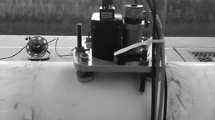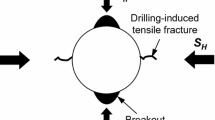The problem of reconstruction of a continuous spatial line of a pipeline by the discrete points measured with some error is solved. For the problem solution, a non-iteration numerical algorithm is proposed, according to which each measured point of the pipeline is treated as a compliant support. The algorithm is based on the method of initial parameters and accounts for the concept of “an incompatibility angle” between two adjoining measured sections of a pipeline axis. Using methods of the probability theory, the analysis is performed, which allows one to assess the accuracy of the reconstructed position of a pipeline and obtained stress values. Accuracy of calculations executed by means of the developed algorithm has been verified using the results obtained by analytical methods.









Similar content being viewed by others
References
M. Dima, “Analytical and numerical flash-algorithms for track fits,” J. Phys. G27, 1481–1492 (2001).
J. A. Christopher, R. Swanson, and T. O. Baldwin “Algorithm for finding the axis of a helix: fast rotational and parametric least-squares methods,” Comput. Chem., 20, 339–345 (1996).
A. Clarke and C. Eberhardt, “The representation of reinforcing fibres in composites as 3D space curves,” Compos. Sci. Technol., 59, 1227–1237 (1999).
D. Hart, N. Zulfiqar, H. Moore, and R. Swank, “‘Digital pigging’ as a basis for improved pipeline structural integrity evaluations,” in: Proc. of IPC 2006 Int. Pipeline Conf. (Sept. 25–29, 2006, Calgary).
H. Aue, S. Paeper, B. Brown, et al., “High-quality geometry module data for pipeline strain analyses,” in: Pigging Products Services Association, PPSA Seminar Paper (2008).
J. A. Chyz and J. R. Adams, “Computation of pipeline-bending strains based on Geopig measurements,” in: Pipeline Pigging and Integrity Monitoring Conference (February, 14–17, 1994, Houston).
P. H. Wagner, X. Luo, and K. A. Stelson, “Smoothing curvature and torsion with spring splines,” Computer-Aided Design, 27, No. 8, 615–626 (1995).
M. Hosaka, Modeling of Curves and Surfaces in CAD/CAM, Springer-Verlag Inc., New York (1992).
G. S. Pisarenko, V. A. Agarev, A. L. Kvitka, et al., Strength of Materials [in Russian], 4th edition, Vyshcha Shkola, Kiev (1979).
I. V. Orynyak, A. V. Bogdan, and V. M. Vasylyuk, “Simulation of the process of drawing a pipe through the pipeline with a larger diameter,” in: Proc. of IPC 2006 Int. Pipeline Conf. (Sept. 25–29, 2006, Calgary) (2006), pp. 931–942.
I. V. Orynyak and A. V. Bogdan, “Problem of large displacements of buried pipelines. Part 1. Working out a numerical procedure,” Strength Mater., 39, No. 3, 257–274 (2007).
I. V. Orynyak and Ye. S. Yakovleva, “Application of the crack compliance method to long axial cracks in pipes with allowance for geometrical nonlinearity and shape imperfections (dents),” Eng. Fract. Mech., 75, No. 14, 4012–4026 (2008).
V. A. Svetlitskii, Mechanics of Flexible Rods and Fibers [in Russian], Mashinostroenie, Moscow (1978).
A. C. Ugural and S. K. Fenster, Advanced Strength and Applied Elasticity, Elsevier (1987).
I. V. Orynyak, S. A. Radchenko, and A. S. Batura, “Calculation of natural and forced vibrations of a piping system. Part 1. Analysis of vibrations of a 3D beam system,” Strength Mater., 39, No. 1, 53–63 (2007).
A. V. Perel’muter and V. I. Slivker, Computational Models of Structures and Possibilities for Their Analysis [in Russian], Stal’, Kiev (2002).
A. B. Ainbinder and A. G. Kamerstein, Strength and Stability Analysis of Main Pipelines [in Russian], Nedra, Moscow (1982).
I. V. Orynyak and S. A. Radchenko, “A mixed-approach analysis of deformations in pipe bends. Part 3. Calculation of bend axis displacements by the method of initial parameters,” Strength Mater., 36, No. 5, 463–472 (2007).
Author information
Authors and Affiliations
Additional information
Translated from Problemy Prochnosti, No. 3, pp. 62 – 83, May – June, 2012.
Rights and permissions
About this article
Cite this article
Orynyak, I.V., Lokhman, I.V. & Bogdan, A.V. Determination of curve characteristics by its discrete points measured with an error and its application to stress analysis for buried pipeline. Strength Mater 44, 268–284 (2012). https://doi.org/10.1007/s11223-012-9380-7
Received:
Published:
Issue Date:
DOI: https://doi.org/10.1007/s11223-012-9380-7




